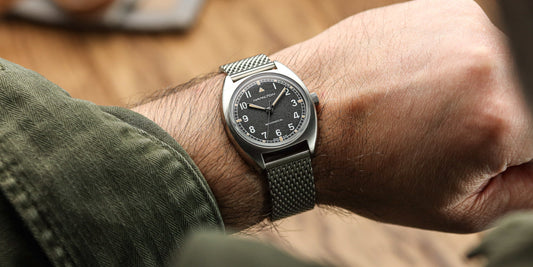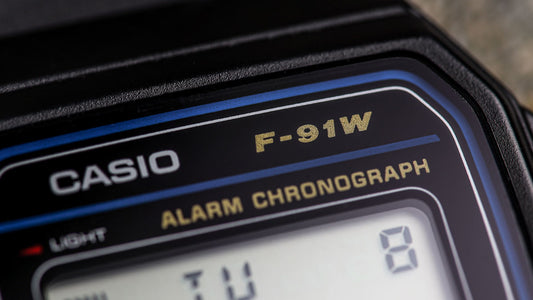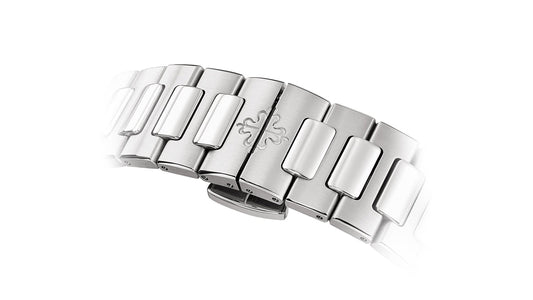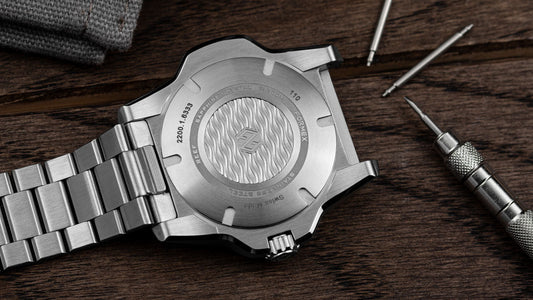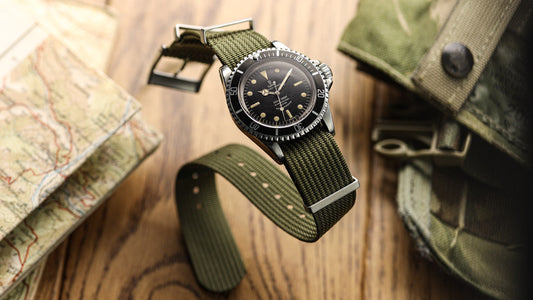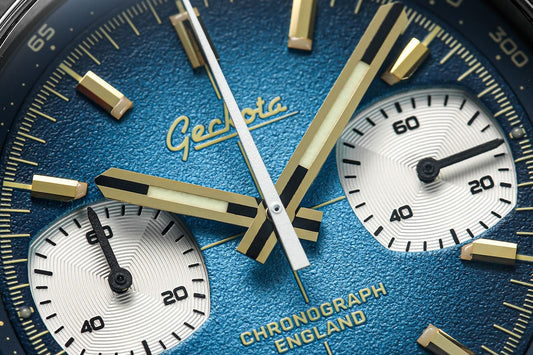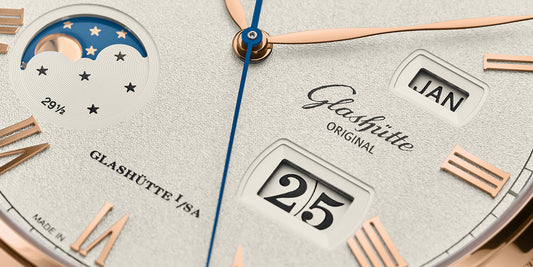The vast majority of people never give a thought to their watch crystal, even though they look at it a hundred times a day! This important component not only allows you to read the information on the dial clearly, but it also keeps dirt, dust, and water from entering the watch. The crystal is, more often than not, held in place by means of friction produced by a collaboration of tolerances. The parts involved are the crystal itself, the crystal seal or gasket, and the case. This friction, or to be technically correct, 'interference fit,' serves two purposes, the first is to ensure that the crystal remains in place, and the second is to provide a seal to prevent the ingress of dirt, dust, and water, as previously mentioned. Firstly we're going to take a look at the three materials used in crystal manufacture, and then we'll move on to cover some different styles.
The Mohs Scale
To demonstrate a mineral's hardness, or to be more specific, scratch resistance, engineers often use the Mohs mineral hardness scale. This scale goes from 0-10, with 10 being the most resilient. It was perceived by the German geologist Friedrich Mohs in 1812 and offers only a comparative view by comparing the ability of one mineral to scratch another. Talc is at number 1, while diamond, along with boron nitride, is at number 10.
Acrylic

Sinn 365 Acrylic Domed Crystal - Credit WatchGecko
Acrylic crystals have been used since the 1920s, and they come in many different trade names; the better-known ones include Hesalite, Perspex, Plexiglas, Crylux, Optix, and Lucite, but there are many more. They are all thermoplastics, meaning that heat will soften the structure but will re-harden when cooled, as opposed to thermosetting plastics that cannot be softened with heat, such as 'Bakelite', another trade name that comes under the heading of phenolics. Although we use the term acrylic, it's actually 'poly methyl methacrylate', and it's a synthetic polymer that's often abbreviated to PMMA. These are termed 'engineering plastics' and are common in our everyday world.
We often term these crystals 'Hesalite,', but technically, that's a name coined by Omega, a bit as we refer to all vacuum cleaners as 'Hoovers.' The hardness of an acrylic crystal is around 3 on the Mohs scale. As with all things, they have their pros and cons. On the upside, acrylic crystals are very impact resistant and tend to 'flex' rather than break or shatter; they are also cheap to make and replace. The downside is that they're relatively soft and scratch quite easily, although these scratches can be removed just as easily with a little elbow grease. They offer a vintage feel to a watch and, if treated with respect, are well up to the job. Acrylic crystals seem to be making a slight comeback, but in reality, their day has gone.
 Acrylic Domed Crystal with Scratch - Credit WatchGecko
Acrylic Domed Crystal with Scratch - Credit WatchGecko
Mineral Crystal
Mineral crystal is a conventional glass produced from silica and is often tempered to increase its resilience to damage. Mineral crystals are much more scratch resistant than acrylic crystals; even so, scratches may still be encountered; light scratches may be polished out of mineral crystal using a suitable abrasive compound and a little patience. Seiko's 'Hardlex' is a mineral crystal that's been heat treated; in addition to this, inorganic chemicals have been added to the surface in order to increase its desirable properties, including scratch resistance. Seiko's 'Hardlex' is difficult to nail down on the Mohs scale because it's available in various grades, but it's much more scratch resistant than normal mineral crystal, which comes in at around 5 on the Mohs scale.
Mineral crystals also have their pros and cons.On the upside, they don't shatter like sapphire crystals and are tougher generally; they are also cheaper to replace than a sapphire crystal. On the downside, they are not quite as scratch resistant as a sapphire crystal. It's often said that a good mineral crystal such as Seiko's 'Hardlex' is the best choice for watches that will be used for diving and other demanding conditions where toughness is absolutely paramount. I've dived with mineral and sapphire crystals and had no issues with either. In reality, the crystals on deep dive watches are so thick that you'd have to be hit by a nuclear sub to break either!
Sapphire Crystal

Seiko Willard Sapphire Crystal - Credit WatchGecko
Often referred to as the 'Gold Standard' for watch crystals. Sapphire crystal is a synthetic material that involves crystallizing pure aluminum oxide at extremely high temperatures. The result is an exceptionally hard, colorless ceramic that achieves a hardness of 9 on the Mohs scale. As with all the others, sapphire crystals have their pros and cons. The upside is their incredible hardness and scratch resistance, along with their remarkable clarity. The downside of a sapphire crystal is its vulnerability to shattering; it's also the most expensive to replace! Sapphire crystals are found on the very best watches, although they are now becoming the norm on many everyday watches. They really are a giant leap forward in watch crystal technology. I've never scratched or damaged one yet, even in my job!
Hybrid Crystals
'Sapphlex' is another Seiko invention that's a hybrid. In simple terms, it's a 'Hardlex' crystal with a sapphire coating, giving it the best of both worlds! 'Sapphlex' offers the hardness and scratch resistance of sapphire while offering the same inherent toughness as a 'Hardlex' crystal. 'Sapphlex' and 'Hardlex' are only available on Seiko watches as both are Seiko registered.
Different Styles of Crystal
We've looked at the different crystal materials, but that's not all the story. To finish off, we should take a look at the shape of our chosen crystal. There are flat, single-domed, double-domed, high-domed, faceted, concave, and top hat crystals to choose from; each gives the watch a different look.
 Flat Sapphire Crystal - Credit WatchGecko
Flat Sapphire Crystal - Credit WatchGecko
The flat crystal is just that and needs little explanation. The single-domed crystal adds a little shape as it's domed on the upper surface only. These normally blend seamlessly with the bezel and look classy. Their trademark is that they distort the dial at the edges giving a somewhat vintage look.
Double-domed crystals are also domed on the underside, and while they look identical to the single-domed crystal, they produce little distortion at the edge. High-domed crystals just have a more aggressive dome that sits higher; they can be single or double, with the single producing more distortion at the edges. Faceted crystals are often cut to offer better vision at odd angles, while some are just cut for effect.
Concave crystals are rarely seen and offer a different look. Top hat or box crystals rise above the bezel, often with straight sides giving a more vintage appearance; They are prone to getting knocked on the edge as they protrude above the bezel ring.
 Omega Speedmaster Sapphire Boxed-Crystal - Credit WatchGecko
Omega Speedmaster Sapphire Boxed-Crystal - Credit WatchGecko
I hope that's made things a little 'clearer', although it's only really 'scratched' the surface (sorry about that one, low-hanging fruit, you know how it is).
These relatively short articles are meant to offer a brief insight into the things that often go unnoticed but nevertheless are quite involved. Watch crystals are, more often than not, pressed in. This works well as any external pressure just adds to the pressure on the seal, making it more efficient; however, diving watches can suffer internal over-pressurization in decompression due to the ingress of helium gas when saturation diving; this can 'blow out' the crystal as the pressure being applied is diametrically opposed to that of the design. Some watches are fitted with a helium escape valve to allow this internal over-pressure to equalize, but some companies, like Seiko, hold some of their crystals in place mechanically with a castellated nut; this not only prevents the crystal from blowing out it also offers a better, more predictable 'seal' in the first place. Perhaps helium escape valves will feature in a future article, along with how the helium gas gets into the watch in the first place!






